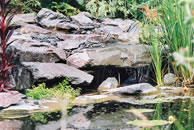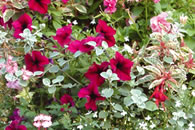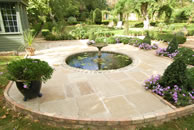|
Remove the net if necessary.
Observe the pond in its entirety before commencement of work and be sure that nothing untoward has happened.
Test the water, nitrite, ammonia, nitrate and ph. Ensure that your water quality is within the recommended parameters and if so carry on….
Hoover any excess sediment from the bottom; this doesn’t need to be hygienically clean but in a position to accept the ingress of the busy feeding season. In doing this you are also carrying out a water change, again good positive stuff. I would hope this to be no more than 25%. Be careful to avoid any frog spawn or tadpoles.
Ok the reason for doing that first was to avoid stirring up the water. Your pond needs to be nice and clear, so you can see what you are doing! Start filling the pond up, don’t forget to calculate the amount of water that is going to go back in and de-chlorinate it.
L x W x D (feet) x 6.25 = gallons L x W x D (metres) x 1000 = litres
In theory your plants were cut back in the autumn, leaving you not much to do to them. If you need reduce any marginal type plants, do this now. Remember they will grow hugely over the course of the summer! Lilies generally need to be split every two years, but please refrain from doing this until there is plenty of growth and they are looking strong. Ensure your oxygenating plant has survived and replenish if not. Add some fertiliser to your plants if new or nitrate level is particularly low. Avoid fertilisers with any phosphate or nitrate in them.
Now for your equipment, your pumps, we are lucky these days. Modern pump design and reliability allows us not to worry about cleaning our pump too much. But I recommend strongly that your pumps submersible, it is pulled out, carefully just in case the hosing is brittle (it always snapped in the most awkward place). Now it might not look as if it needs a clean, but inside that casing it’s probably full of gunk. So open her up and give that casing the once over. Check the impellor, make sure it moves freely and there’s no sign of lime scale. Also check the outlet for congestion, ensure the hose is firmly fixed and any settings remain as they should. Good now we have an efficient source of water, now let’s make sure your filter is capable of dealing with it.
Your ultra violet filter, this is normally the first port of call. Turn all of the equipment off and remove any housing as to expose the bulb and quartz sleeve (the bit around the bulb). There should be no water within the quartz sleeve, if there is check the seals if they are perished or stretched or compromised in any way, replace them. It is prudent to do this every other year. If you need to, when you go to buy them, buy a few because they are cheap and your filter may become obsolete at some point making spares difficult to find. If they are intact, then carefully check the quartz sleeve, a hair liner crack can cause water ingress and replace if necessary. If not, clean the quartz sleeve, CAREFULLY! (it is super fragile and expensive to replace). If any collected matter is stubborn, it is likely to be lime scale (if you live anywhere near we do anyway) A proprietary and preferably acid based remover is good. Watch your fingers, wear gloves! Replace the bulb now, check the wattage on the one that comes out and check the one that goes in is the same and try to avoid touching the glass. Please note your old bulb may still illuminate but it will not be as effective enough. We are heading towards summer and I know the amount of sunshine we get isn’t enough, but it’s the sun that turns the water green, so a new bulb in the spring ready for the sunnier days. There will be enough good intensity to see you through to the winter and keep your pond good and clear, assuming that the UV is of the right size and your equipment is maintained correctly!
Now for the filter box, thoroughly clean the foams and any other mechanical media, brushes, jap matting etc. this should be done preferably in water from your pond (but obviously not in your pond). As for the biological stuff, give it a swill around with some pond water, ensuring that is good and clean. Encouraging that all important denitrifying bacteria to colonise in a super efficient way. Please avoid rinsing through with tap water. If you have a large stocking of fish in your pond it may be an idea to introduce some bacteria to your filter, just to kick start everything after the winter and perhaps be sparing with the food for the early weeks. Turn it on and check your plumbing thoroughly for any leaks, also be aware of any degradation and try to consider replacing any susceptible hosing before a problem occurs.
Now back to the pond, which should be full by now. Your fish will be feeling the effects of a harsh winter and are more susceptible to parasites and bacterial infection at this time of year. Now we have done everything to your pond to ensure that is in the right condition so your fish should be happy and grow well. I would however recommend that you carry out a treatment that will cater for both parasites and harmful bacteria. This will make sure your fish are fighting fit and ready for action. Be aware of what fish are in your pond and make sure the treatment you buy is safe for your fish. Once administered, turn the UV filter off for about 24 hours or so (make sure that before you turn it off that you have checked that it is working after replacing the bulb earlier) Ensure that the pump is agitating the water surface vigorously and there is plenty of oxygen available for the fish.
This is a guide and of course we know that all ponds are different, so if you need any further advice on your specific situation then please send an email.
If you tend your own pond make yourself known to us. |



